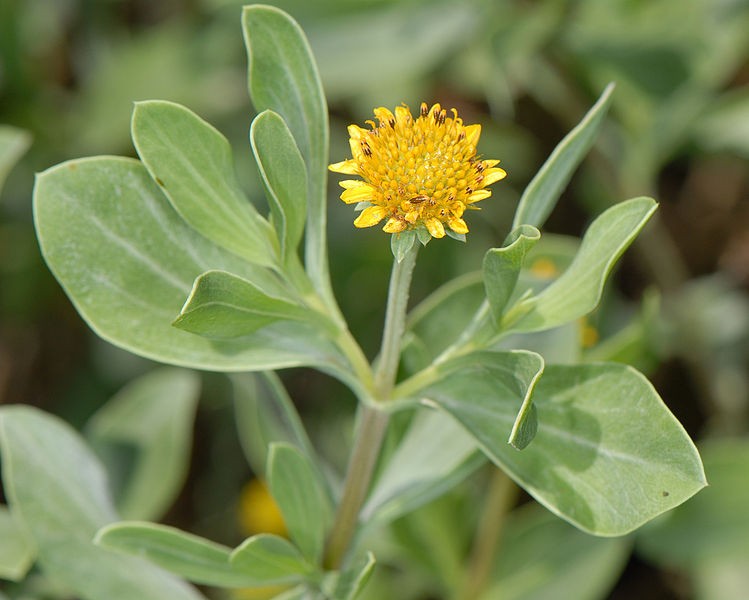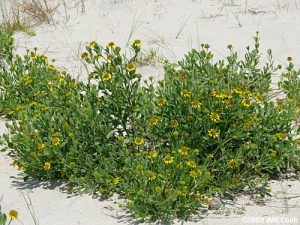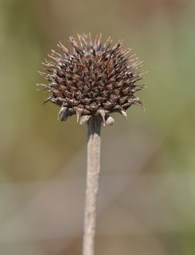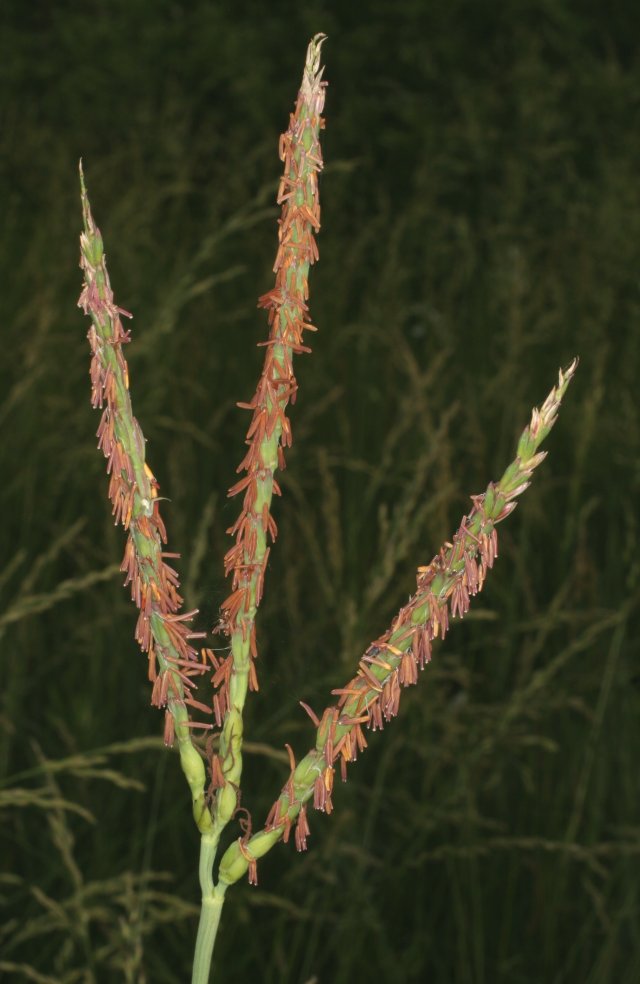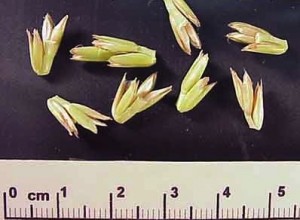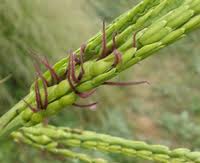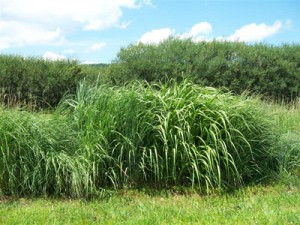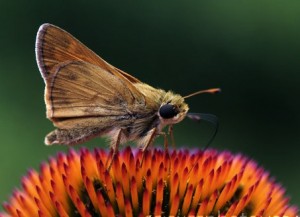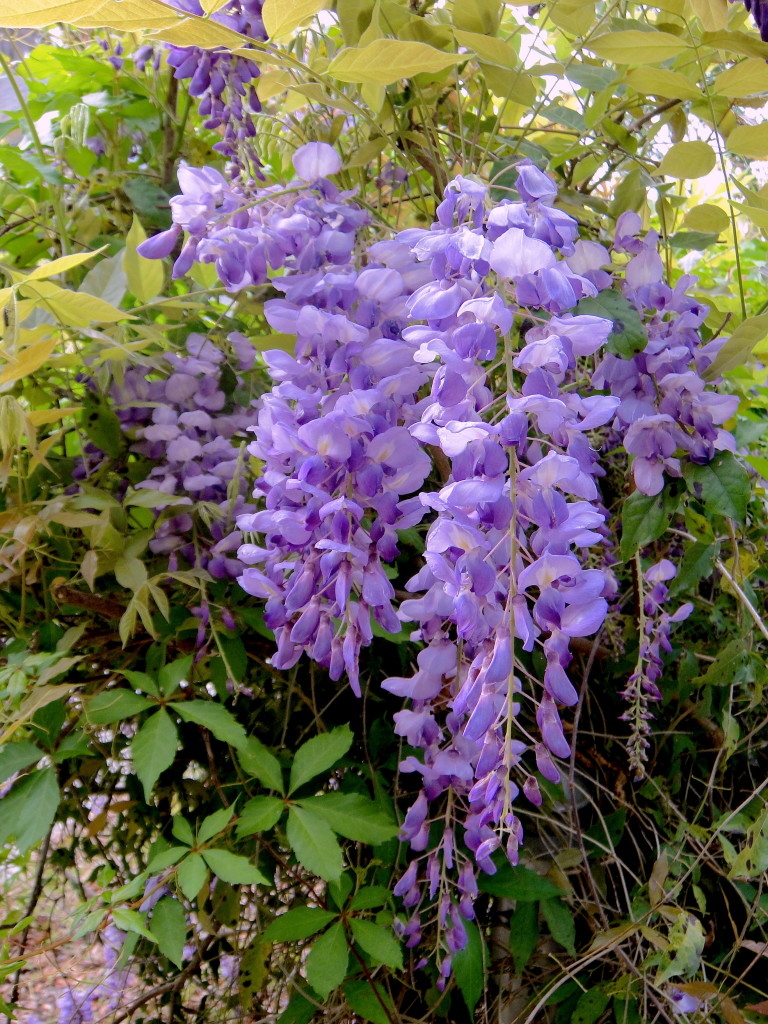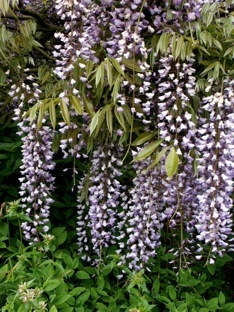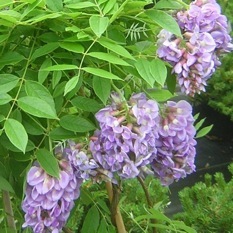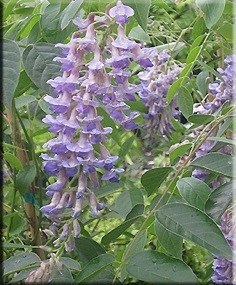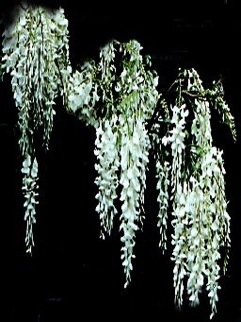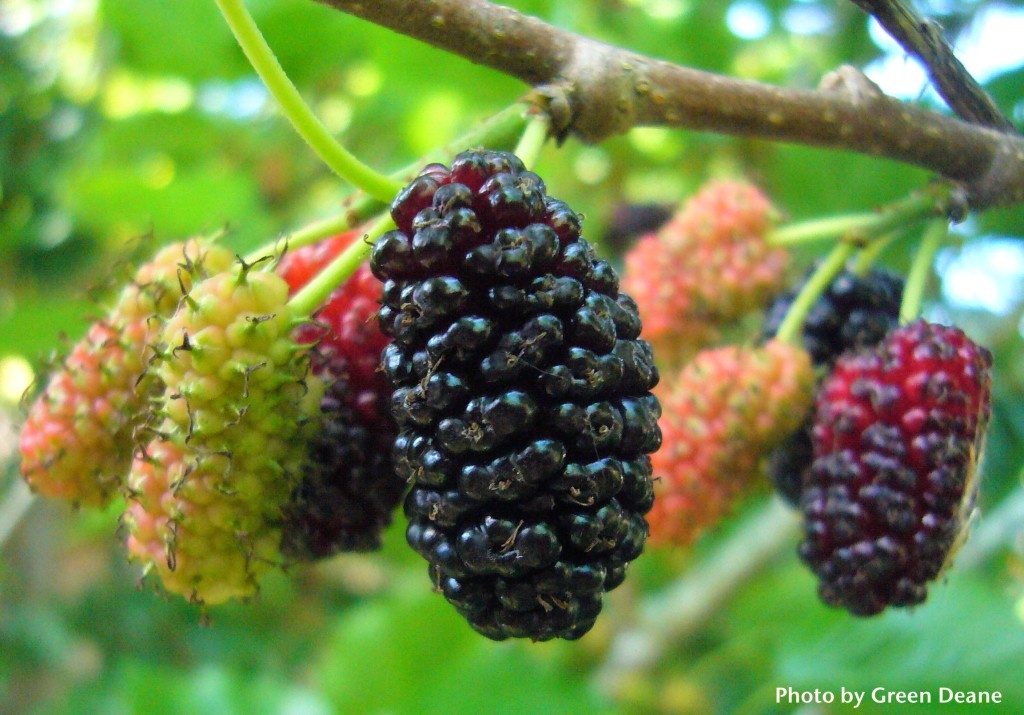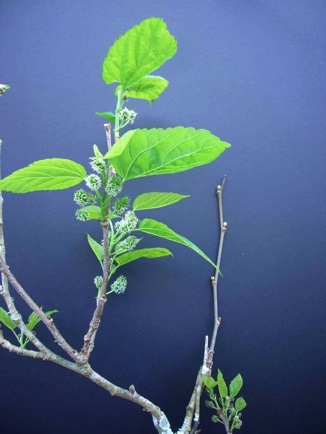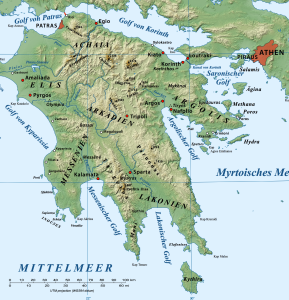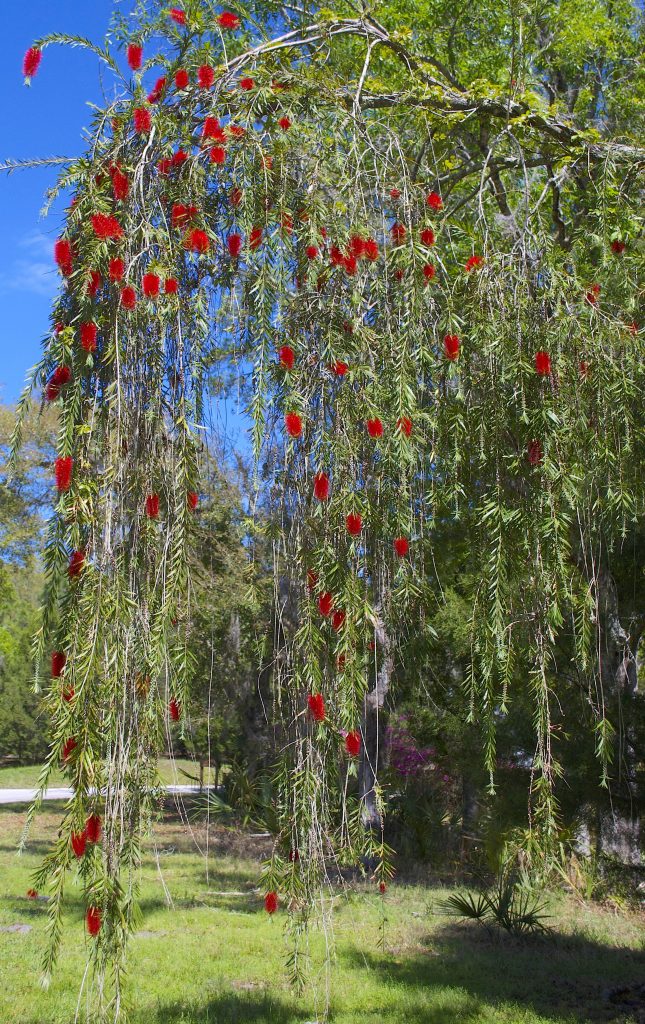
The Weeping Bottlebrush Tree is native to Australia. Photo by Green Deane
I’m often asked during my classes why I mention many plants that can be used to make tea. There are two answers: One is that different teas can be pleasurable if not healthy. The other answer is more practical: Leaves that can made into tea can often be use for flavoring like a bay leaf, or, a leaf that can make a tea can be a possible marinade. Why a marinade? Flavor. The menu for the natives only changed with the season so anything they could do to improve the taste of a day-in day-out food was welcomed. Those leaves can also be stuffed into vegetables and beasts about to be roasted.
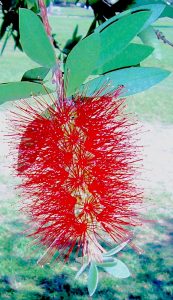
Tea can be made from the blossom or leaves. Photo by Green Deane
While there are many native species that can be used for tea there’s also an imported ornamental that available as well, the Bottlebrush Tree, or Callistemon citrinus (kal-liss-STEE-mawn sih-TRY-nus, or, sit-REE-nus.) It is reported that all of the Callistemon species can be used the same way but I personally don’t know that for certain. You can use either the Callistemon citrinus leaves or blossoms to make a tea or use the leaves to make a tea and use the blossom to sweeten the tea. A very close relative of the Callistemon is the Melaleuca (to see separate entry ) It’s leaves can also be used to make a tea and the blossom to sweeten it. The main difference between the two species is that the stamens (male parts of the flower) are generally free in the Callistemon but grouped into bundles in Melaleuca. Another difference is that Melaleucas like wet places and Callistemons dryer locations. One look, however, at the leaves, blossoms and fruit and it is clear they are related. At one time the Callistemons were in the Melaleuca genus and some botanists still put them there. As for other uses a tan dye is made from the flowers and with a mordant they dye green. A cinnamon dye can also be made from the leaves. The wood is hard, heavy, tough, and close grained. It’s used for tool handles and fuel.
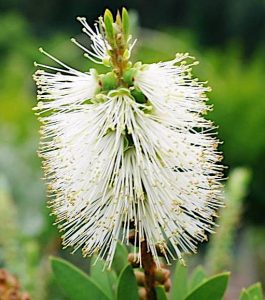
Bottlebrush blossoms can also be white.
Besides the Bottlebrush Tree other common names include the Red Bottlebrush, Lemon Bottlebrush, and Crimsom Bottlebrush. The genus name Callistemon was created by Robert Brown (1773 – 1858) a Scottish botanist who made significant contributions to botany by using the microscope (read making small differences into big differences.) Callistemon is two mangled Greek words, “kallis” (beautiful) and “stemon” (stamen.) Together they mean “beautiful stamens.” The species name, citrinus, means like citrus. Remember the blossom looks like a bottlebrush, not a pom-pom. If you have a pom-pom blossom you have a different species altogether. Incidentally, the name “Lemon Bottlebrush Tree” comes from the aroma of the leaves, not from any color per se.
Green Deane’s Itemized Plant Profile
IDENTIFICATION: A small tree or large shrub, 6-12 ft (2-4 m) tall and 6-9 ft (2-3 m) wide. Leaves narrow, lance shaped, leathery, distinctly citrus aroma. Fuzzy-looking flowers composed mostly of stamens. Bark moderately rough, light brown.
TIME OF YEAR: Leaves year round, blossoms heavily in early spring with red flowers followed by some blossoms in summer.
ENVIRONMENT: Native to Australia and New Caledonia it likes well-drained soil, sandy loam. Will not thrive in heavy soil or soggy ground. Can take some salt spray, likes full sun. Drought tolerant once established. While planted ornamentally in warm areas throughout the world it is naturalized in Louisiana and Puerto Rico.
METHOD OF PREPARATION: Blossoms soaked in hot liquid to release nectar to sweeten, leaves used to make a tea.
How embarrassing. A week after posting the article above I found one I wrote two years earlier and never published. It was on a thumb drive, not my main computer. It has some more information:
Callistemon citrinus
Some plants are at the same time easy and difficult to identify. Wild grapes are a good example. The genus is usually easy to sort out but exactly which species can be elusive. The Bottlebrushes can have similar issues.
While native foragers had no issues with the Bottlebrush tree and its close relative, the Melaleuca, botanists did, eventually putting them into two different genus. The trees are clearly related and look similar from leaves to blossoms to seeds.
The main difference among them is Bottlebrush blossoms have “free” stamens and the Melaleuca bossoms have “united” stamens. What does that mean? The stamen of the bottlebrush stand apart like separate hairs whereas the Melaleuca are like upside down little brooms, many stamens on one stem. However, some botanists think this slight difference is not enough for them to be two separate species. They argue the Bottlebrushes should be merged into the Melaleucas, and some published works have done that but not without controversy. With that thought in mind also know that not all Melaleucas have cylinder-shaped blossoms. Reclassification, reunification, or agreement is probably a long ways off. Fortunately foragers are not bothered by such tempests.
The blossoms of all the Bottlebrushes (and Melaleucas) can be used to make a sweet tea, or to to sweeten other teas. Callistemon blossoms are usually red but they can also be yellow, green, orange or white. They produce a triple-celled seed capsule which remains on the tree until the plant dies or a fire causes the release of seeds. The seed capsules resemble beads on a bracelets.
Best known among the Bottleburshes for leaf tea is the Lemon Bottlebrush, Callistemon citrinus aka Callistemon lanceolatus. The leaves only need to soak in hot water. While that is fairly straightforward, the question is which Bottlebrush is the C. citrinus?
The most common Bottlebrush species one will encounter locally is the C. viminalis, also called the Weeping Bottlebrush. Like a weeping willow the branches droop extensively. Its “brushes’ are very cylindrical and about six inches long. The leaves, which smell more medicinal than citrusy, are around three inches long, skinny, linear, stiletto-shaped, pointed, and drab green. The leaves lateral’s veins (coming out from the midrib) are nearly obscure. The seeds capsules are flatish on top, or “not contracted” looking like little cups almost full, a ring around the top. Locally the tree can grow to 20 feet. In Jamaica it has been used for generations for a hot drink call “tea” used for the treatment of gastro-enteritis, diarrhea and skin infections. Again, separate tests extracts were antibacterial and antifungal activity against gram-positive and gram negative bacteria.
The less common but more desirable C. citrinus weeps as well, but not as much. Its leaves smell lemony when rubbed (not crushed) and its “brushes” are slightly egg shaped and shorter than the C. viminalis, two to four inches. Young leaves of the C. citrinus are fuzzy and coppery later turning drab green. Mature leaves are about three inches long, more a long oval than stiletto shaped. The round tip has a sharp point and the leaf evergreen. The seed capsules are puckered at the top, or “contracted” with a small hole in the middle. Locally the tree grows to 10 feet or so. There are dwarf versions, so use your nose.
Be advised some websites — copying each other no doubt — say the entire tree is poisonous though they have been used to make tea for virtually thousands of years. The leaves of the genus have been studied extensively. A methanolic extract of them is antibacterial, antifungal, and antioxidant in activity. The extract works against both gram positive as well as gram negative bacteria as well as some fungal species.
In a 2010 report (Am. J. Applied Sci. 7 (1) 13-16) leaves of C. citrinus were shade dried for 48 hours and crushed into a powder using a blender. Six grams of powder were used in 10 ml of ethanol distilled water to make an ethanol extract and 10 mls of of methanol distilled water for a methanolic extraction. They were then centrifuged (3,000 rpms) for 15 minutes and clear liquid harvested. This was done three times then the alcohol evaporated by incubating at room temperature. They, too, had antibacterial and antifungal activity.
In their native range in Australia the Cellistemon is often the host to the larval stage of the cossid moths, Endoxyla leucomochla and Hepialidae, aka the Witchetty grub, a popular raw or cooked food of the Aboriginals. They have an almond taste with the consistency of egg and when cooked have a crispness like fried chicken.
Upright small tree or large shrub, 6′-12′ high by 6′-8′ wide. Leaves are narrow, lance shaped, and leathery, with a distinctly citrus aroma (thus the common name). Bright red, plump, bottle-brush shaped flowers composed mostly of stamens bloom off and on throughout hot weather. Bark is somewhat rough and light brown.
Herb blurb
Molecules. 2009 Jun 2;14(6):1990-8.
Chemical composition and antibacterial activity of the essential oils of Callistemon citrinus and Callistemon viminalis from South Africa.
Oyedeji OO, Lawal OA, Shode FO, Oyedeji AO.
School of Chemistry, University of KwaZulu-Natal, Westville Campus, South Africa. aoyedeji@pan.uzulu.ac.za
Abstract
The chemical composition and the antibacterial activity of the essential oils obtained by hydrodistillation from the leaves of Callistemon citrinus and Callistemon viminalis were analyzed by GC and GC/MS. Twenty-four and twelve components were identified for C. citrinus and C. viminalis, representing 92.0% and 98.3% of the total oils. The major components of C. citrinus and C. viminalis were 1,8-cineole (61.2% and 83.2%) and alpha-pinene (13.4% and 6.4%), respectively. The in vitro antibacterial activity of the essential oils was studied against 12 bacteria strains using disc diffusion and broth microdilution methods. The oils exhibited strong zone of inhibitions against some bacteria such as S. faecalis (20.3-24.0 mm), both strains of S. aureus (23.0-26.3 mm), B. cereus (17.3-19.0 mm) and S. macrcesens (11.3-23.7 mm) when compared to standard antibiotics gentamycin and tetracycline used as controls. Expect for P. aeruginosa and S. macrcescens, the MIC values of both essential oils ranged from 0.31-2.50 mg/mL.
